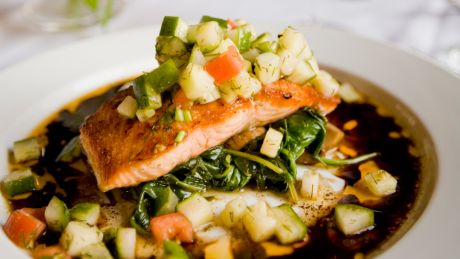What to Eat When You’re Training for an Endurance Challenge
Whether you’ve set your sights on the Fitbit Fifty or your local 5K, progress starts in the kitchen

You’ve put in the hard hours on the bike, the early morning runs, the lung-busting brick sessions, even the odd excruciating sports massage (recovery, after all, is when you get better). But there’s another part of training to consider and without it there’s a very good chance you’ll never see the finish line.
What you put in your mouth, and when, gets more important the longer the event you’re training for. So for the participants in the two-day Fitbit Fifty challenge – who’ll be running and cycling in teams from London to Edinburgh and back – nutrition is paramount. But even if you’ve set your sights on a more modest event – a sportive, say, or a marathon – you can use the same principles to make sure you give your best performance on the day.
In the Kitchen
First things first: there’s a difference between what you eat on the road and what you eat off it. The best time to worry about good health and nutrient density is when your training’s over for the day – that’s when you should aim for at least 20g of protein and a healthy heap of green veg on your plate. You should also make sure you’re getting enough fat to support your efforts – if you’re training for an event, it isn’t the time to worry about fat loss.
“Knowing how many calories I’ve burned throughout a whole day, not just during the workout, is important for me to understand how much I need to eat to ensure I’m fuelling performance,” says triathlete Mike Vulanich. “I use the data that uploads to Fitbit – which uses heart-rate data to estimate the calories you’ve burned – to make sure I’m getting enough.”
In Training
“The golden rule for any endurance event is to not try anything in the event you haven’t tried in training,” says John Readman, a cycle event organiser and veteran of 100-mile-a-day rides. “You want to use your training sessions to find out what works for you. Some people like gels, but they can stop things coming out or start them coming out faster. Personally, I take bananas, dates, nuts and a load of homemade flapjacks – but you should experiment.”
And remember, you’re teaching your body to digest food on the go just as much as you’re training your legs and lungs. “You’re training your gut and your mind so you’re in the mindset of eating automatically before you feel hungry,” says OnePro Cycling coach James McCallum. Practise the strategy you’ll use in the race and it will be one less thing to worry about on the day.
During the Event
“Imagine you start in the morning dragging a bag of sand with a hole in it,” says McCallum. “If you drag it around without filling it up, if you’re not paying attention, at some point it will be empty. By that stage, it’s too late to do much about it.”
The trick to avoiding an embarrassing “bonk”, when you run out of energy and have to stop? Eat early and often. “For any event that lasts more than 90 minutes, you want to get 60g of carbohydrates down you every hour,” says McCallum. “When I did a record-breaking 24-hour ride in Scotland, I had a water bottle with carbs, electrolytes and branched-chain amino acids to maintain healthy muscles. Eventually they’ll stop working, but you want to delay that as long as possible.”
For our Fitbit Fifty entrants, it’s a good idea to keep a few options on hand, just in case choking down another banana gets tiresome after 36 hours. “It might be that they end up drinking milkshakes and eating Haribo – it’s about finding something that’s easily digestible and palatable.”
And if you’re in any doubt about whether you’re getting enough, track it. It’s better to be safe than bonk, after all.
Sign up for workout ideas, training advice, reviews of the latest gear and more.
From 2008 to 2018, Joel worked for Men's Fitness, which predated, and then shared a website with, Coach. Though he spent years running the hills of Bath, he’s since ditched his trainers for a succession of Converse high-tops, since they’re better suited to his love of pulling vans, lifting cars, and hefting logs in a succession of strongman competitions.

